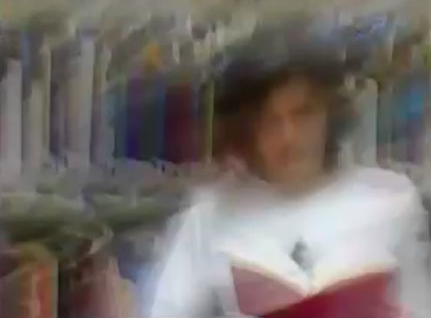
Amerika describes himself as a "thoughtographer", an "artist-medium", a "fictional philosopher", a "remixologist", a "network conductor", a wanderer who constantly changes identities and roles in a fragmentary world where time acquires an a-synchronic and non real dimension. By trying to express the complexity and the interest of contemporary digital reality, he delves into different aspects of himself and draws on elements and traits that he transfers to the characters of his works, by using the media, the technological platforms of our time. Developing projects on the net, filming with mobile phones, remixing common moments and figures of today's culture in a VJ-like audiovisual rhythm, Amerika redefines the characteristics of today's culture and opens up the possibilities for new interpretations and thoughts from the audience itself. -- "UNREALTIME" at the National Museum of Contemporary Art in Athens
Rick Silva: The announcement for your retrospective in Greece (your third retrospective right?!) says "The exhibition will also include the European premiere of his most recent work, Immobilité, the first feature-length work released in his 'Foreign Film Series.' I really liked this quote you told me once, I think it was by Atom Egoyan, that "every film is a foreign film"... how does that quote resonate with this new work/series?
Mark Amerika: "UNREALTIME," the exhibition in Athens, is by far the most comprehensive of all of my prior "retrospectives." In 2001-2002, we were having some fun with the notion of "Internet time" and tried to play with the idea of a retro-spective in relation to a lot of the net art I had created in the 90s. Those shows were at the ICA in London and the Media Arts Plaza in Tokyo. Two more followed in 2004, one in Bilbao and one in Sao Paulo, but just in terms of size, the way my work is distributed throughout the museum space, and the variety of work covered -- net art, digital video and surround sound installation, the new mobile phone works, and various language art pieces, going through the show in Athens feels like a very intense experience.
This is partly due to the inclusion of Immobilité. The work runs 75 minutes and is being projected as a wide screen cinematic installation in the big Project Room in the museum. As I was making Immobilité, I was intentionally modeling it after what in the past we have called art-house films or, for the purposes of my new body of work, foreign films. For me, all films are foreign because they take me into another world that defamiliarizes my own and, in the process, exiles me from myself so that I too can become foreign and enter that altered world I need to immerse myself in when creating.
-->Besides, I am especially attracted to some of the more experimental, visionary artworks composed by artists like Chris Marker and Agnes Varda as well as the work of Antonioni, Bergman, Cassavetes, Fellini, Godard, and Kar-Wai. There is something about the way that these other artists oscillate between interior and exterior landscapes that really speaks to me. I have also seen multi-media exhibitions by both Godard and Varda and have navigated through CD-ROMs by Marker, so it's not that odd to go in the other direction, i.e. from novel writing and net art and VJ performance into feature-length filmmaking-as-art. Although it should be said that my idea was not to make a film per se, but to literally remix the form of a feature-length foreign film so that it felt like something you would see in an art-house theater but that was clearly not a major motion picture and would be best experienced as a museum installation. To achieve this, I went very D-I-Y, and shot the work entirely on mobile phone and essentially mashed-up a more amateurish visual aesthetic with my over-the-top auteur-ish methods. For example, there are many of these "painterly" scenes that point back to the abstract expressionist roots of the art scene that has come out of the Cornwall region of the UK where the work was shot. These painterly images were made not in After-Effects, in fact there are no slick, Jeremy Blake-like composites in the work, but rather flickering color fields and character portraits created using experimental hand-held techniques, something that you can really play with once you get a feel for the mobile phone as capturing device. As odd as it may sound, I imagined the mobile phone as part image capturing device, part paintbrush, and part communications gadget during the entire production.
Of course, as with all of my prior work, Immobilité is an expansion of my creative writing practice too and consists of subtitles that also remix both philosophical and literary texts that have informed my own writing style for over 25 years. As with all foreign films, the only way to see Immobilité is to read it.
RS: This idea of 'remixing the form' goes all the way back to your first new media work GRAMMATRON, where you basically wrote a novel as a multimedia hypertext website. Do you think we are in a post remix era, as in post taking-content-directly-from-other-people's-works, and maybe more about remixing aesthetic or structural forms?
MA: My sense is that it's an "all of the above" situation that has been happening for awhile now and that, out of necessity, we find ourselves becoming not so much contemporary artists (i.e. "of" our time) but temporary artists, something much more fluid in the sense that we are continually caught in the post-production process which for me is the same thing as the creative process. Being creative is what it means to be an aesthetic creature, i.e. one who remixes forms and content as part of their ongoing quest for novelty. This is something that we can trace back to the philosophy of Alfred North Whitehead whose books, particularly Process and Reality, highlight how we quite naturally select useful source material, what he calls datum, and reconfigure it for our own creative needs. So yes, on a practical level, remix culture is about sampling content and manipulating it for temporary effect, but on a philosophical level it goes much deeper than that, where we are intersubjectively jamming with the cultural moment we are part of while at the same time sampling from cultural forms we have inherited. With GRAMMATRON, I am noticeably remixing the formal experiments we find in metafiction, hypertext, and conceptual art+language works while unknowingly helping usher in a new genre that we have since come to call Internet art. The buzz from the discoveries made during the making of GRAMMATRON is then integrated into PHON:E:ME, where I remix the form of the concept album with forms I associate with Conceptual Art while at the same time expanding the concept of peer-to-peer networking, and then with FILMTEXT I try to mash-up a lot of different forms including interactive cinema, games, cyberpunk fiction and what had by then become net art.
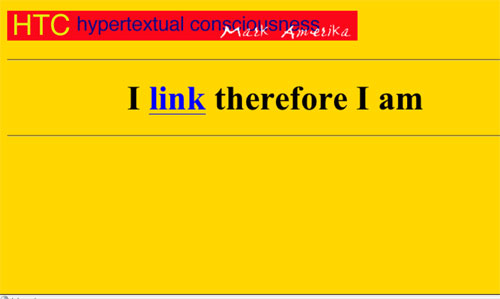
But at a certain point, around 2001-2002, I realized that it was time to expand out of net art into other forms. What I noticed was that the more visual and interactive the work became, the more it begged for performance, so I began taking source material from FILMTEXT and started remixing it in live performances, what we were then referring to as VJ-ing which plays with the idea of "live cinema" or "live A/V." These are all just ways of advancing creativity as part of an aesthetically-induced, temporal achievement. Although, seeing a solid sample of the work I have created over the last twelve years distributed in the large museum space in Athens, brings home the idea that what my body of work is really investigating over time is the way digital media facilitates the remixing of persona.
RS: How do the audio/visual elements of FILMTEXT play to the different audiences you distribute the work to via say, a live, physical audience as opposed to a more distributed, online network?
MA: The audiences are changing so it's very tricky to try and anticipate what kind of art experience one can deliver to an imaginary other. For example, some of my live performances are also simultaneously distributed over the net and then archived for future research or remix purposes. One is tempted to say that these changes are almost all technologically induced. But then again, I am the one pulling the trigger. Although once I am performing a live set or enable my online presence to get distributed 24/7 over the matrix, then I start feeling like a network distributed "other" more than I feel like anything I might want to call "me" ("me" who?). This might have something to do with the way we now "play ourselves" as we live out the (re)mixed reality narratives that we call our lives. Perhaps this is what Rimbaud meant when he wrote "I am another."
Don't forget, in the old days, say 10-12 years ago, a lot of the pioneering net artists were both making net art in total isolation yet connecting with their audience via the web and email while at the same time actively circulating in the international media arts festival scene. Once that happens, the audience becomes this imaginary hybrid i.e. a mesh of flesh and avatar-others, one that is constantly shape-shifting into new configurations. For example, take "Open-X" at Ars Electronic in 1997. Look at who was there and you see the core group of international artists who were beginning to define what we now think of as Internet art. "Open-X" was an interesting if slightly odd experience. The work was on the net, but the Pure Net Art Animal was now on display as a kind of novelty item to be observed for its playful tendencies. We weren't really sectioned off into a ghetto; it was more like we or our work process was on visual display in kind of techno-zoo, which made perfect sense since we were becoming part of art history which treats its artists and artworks like a precious species to be preserved in controlled environments.
Since the start, though, I have tried to tie a performance element to my various art projects. With GRAMMATRON, you would have thought the audience was primarily oriented toward experimental electronic literature. Sure, there was some of that, but it was what we call the "art world" that really embraced it when it first launched. When I went on the GRAMMATRON WORLD TOUR in 1997-1998, I was playing the work like a multi-media literary reading, something I picked up from my book tour days with my underground novels like The Kafka Chronicles, the difference being that these so-called readings now had sound art, animated images, and multi-linear narrative routes to navigate through while performing the work live. These were the days when my work was being reviewed by magazines like MAXIMUM ROCKNROLL who at the time put out books like "Book Your Own Fucking Life." The early net art scene was a very DIY scene and that was what attracted me to the idea of pushing it as far as it would go back then. There were no MFA programs dealing with net art in a serious way, that's for sure.
So it was not a big leap for me to then take FILMTEXT on the road as part of a live A/V or DJ/VJ performance act. The work opened at my solo exhibition at the ICA in London 2001-2002, and was presented as a cluster of projects that could be interacted with or activated over the Internet: the main digital narrative / Flash interface, a downloadable artist e-book, and an mp3 concept album. But then ten months later started the performances. The main difference between the GRAMMATRON readings-cum-performances and the FILMTEXT performances was that the source material became more translocal because we would supplement the source material from the net art version of FILMTEXT with new source material from wherever we were in the world performing our live A/V gigs. Whether we were in Basel or Tokyo we would record local video and sound data and integrate it into the gig later that night, which then led to all kinds of wildstyle philosophical tripping. This all fed into what I know think of the VJ Persona tour. I remember being in Tokyo, Sao Paulo, and the Canary Islands all in a five-week period -- I was even teaching two new media art seminars as part of my professorial duties -- and realizing that the "jet-lag consciousness" as I call it, i.e. the time-tripping through international time zones while recording and remixing my memories, imaginary experiences, and translocal source material, created a more immersive net art practice than I had previously imagined. Since I am addicted to writing (Cocteau: "Writing is a sickness." / Bataille: "I write not to be mad."), I have documented these experiences in META/DATA: A Digital Poetics (MIT Press) in both theoretical and fictional forms. Cf. "The Random Life of VJ Persona (A Mobile Medium in the Form of a Fiction)". In the book, VJ Persona is a nomadic net artist whose digital personae operates in asynchronous realtime, which is a kind of UNREALTIME, thus the connection to the title of the exhibition in Athens right now.
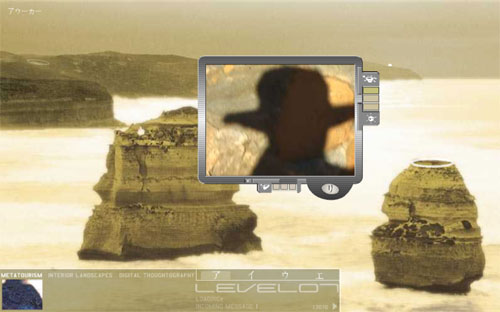
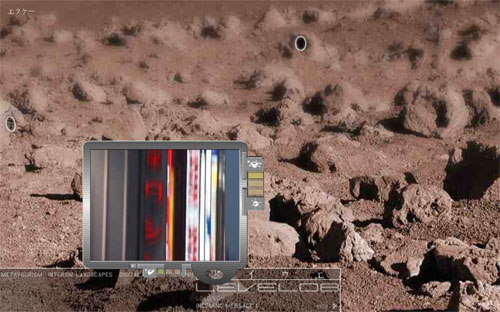
RS: When I look across your various works, some major themes that rise to the surface for me are; the future slipping into the past, the virtual slipping into the real, and the self/artist and the body as it negotiates these slippages. Other themes just below the surface are language, sex, politics, and place. Do you see that as fair reading of the work? Am I missing a big aesthetic or philosophical concern in there?
MA: As I look at my body of work to date, starting with the novels and working through the net art, the multi-media museum installations, the live A/V performances and now the feature-length films, the thing that stands out is how much my methodologies depend on what I call remixological inhabitation -- something that artists of all stripes have been doing in a visible form forever (think of Chaucer referring to himself as "The Compiler"). One can see the residue of "play-giarists," appropriation artists, and cut-up practitioners like Lautréamont, William Burroughs, Kathy Acker, and Raymond Federman all throughout my work. This may be why I enjoyed hanging out with Acker and Federman and was attracted to Burroughs as well, especially the way they fucked up language with their political forms of sexuality and experimented with their bodies.
All of the talk of hactivism, the gift economy, surf-sample-manipulate, etc, was easy for me to connect with because, in fact, when I look at the real early stuff I was doing even in my teens and early twenties, before I was aware of any the historical lineage of those who stole before me, I can see in my notes that I was seriously mashing up discourses from a lot of different sources. So when you say that you see the virtual slipping into the real, for me the virtual is the Source Material Everywhere and it was made "real" via whatever temporary remix I happened to perform with the material in asynchronous realtime. If I happened to have recorded that performative act then that recording too becomes more source material that can be revised, remixed, or otherwise reconfigured into a composed work of art no matter what medium or genre I am working in and, by the way, the mediums and genres begin to blur in my work too because of all of the transcoding that takes place within these ongoing remixological performances. Immobilité can be read as a film, a video art work, a philosophical treatise, or even a kind of visual novel/installation (loaded terms all, I know). For me it basically comes down to maintaining a "cut-and-paste-as-you-go" open source lifestyle practice where the remnants that you leave behind reveal your formal or stylistic tendencies. Some of these remnants are left on the net, some in institutional or commercial spaces, some are left in the club, and some are left on my computer. The important thing for me is that when I am making a work, I am, to use a sports analogy, "leaving everything on the field" because for me making art is an intense experience where the aesthetic, i.e. the artist-medium performing, meets the prosthetic, i.e. the technological crutch, meets the athletic, i.e. the body losing itself in unconscious creative projection. Producing -- or what I really mean is perpetually postproducing -- one's aesthetic trajectory through history is a durational achievement that challenges our sense of time. It's like what Borges says, "Time is a river which sweeps me along, but I am the river; it is a tiger which destroys me, but I am the tiger; it is a fire which consumes me, but I am the fire."
The reason I keep going back to language, play, sex and politics is because that's all that really matters in the end. Of course, since I am postproducing the kind of art that grows out of a literary sensibility, let's not forget death too. Language, play, sex, politics and death all resonate with my core aesthetic principles which, I was reminded of again last year, are intimately connected to Whitehead's process theory. In Process and Reality, Whitehead declares that "Creativity is the principle of novelty." The word novelty is, for Whitehead, uncharacteristically placed in italics for emphasis. If you read through Whitehead's process theory, especially as it applies to aesthetics, you will see that he not only literally introduces us to the concept of creativity, but that he anticipates the coming of the postproduction artist as creative medium. Remixing, it ends up, is a biological process that feeds into what I am now calling the renewable tradition. How each individual negotiates the Source Material Everywhere is, as you suggest, a slippery process, and informs the development of their remixological style which then can be applied to the making of customized aesthetic experiences.
RS: So, what in the Source Material Everywhere is filtering itself into your upcoming projects?
MA: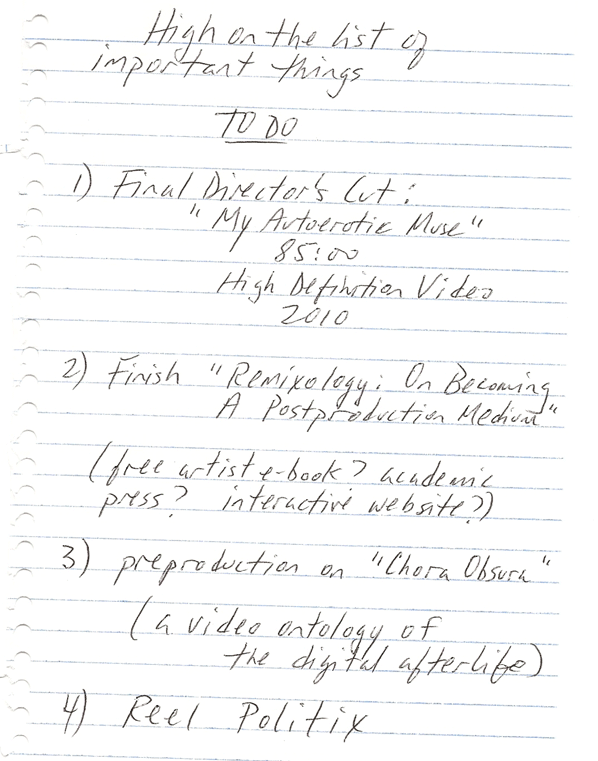
Mark Amerika's comprehensive retrospective ""UNREALTIME" curated by Daphne Dragona runs at the National Museum of Contemporary Art in Athens, Greece, from October 22, 2009 until January 3, 2010.
Rick Silva is a former student and sometimes collaborator of Mark Amerika. The interview was conducted via email.